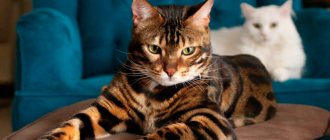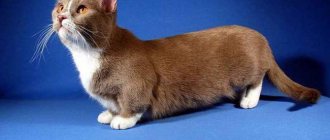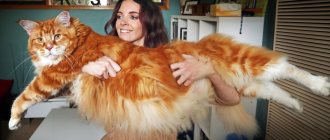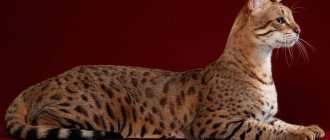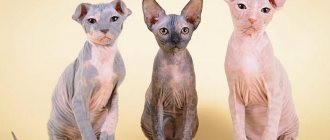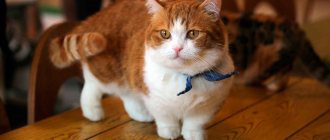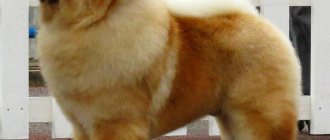The Oriental cat is one of the most promising breeds, since its representatives can satisfy many of the owner’s needs. She is graceful, beautiful, smart and sociable. It is thanks to their friendliness and playfulness that Orientals evoke sympathy.
In addition, the oriental shorthaired beauty does not need special care, the only thing is that due to the lack of undercoat, it is vulnerable to cold.
History of the origin of the breed
The name can be translated from English as “eastern”. But the Oriental breed has a huge and branchy family tree.
For the first time, the oriental cat was mentioned in the Thai manuscript “Book of Poems about Cats” in 1358. For a long time, the East did not allow the export of the Oriental breed from the country, which did not allow the world to know about it. Fortunately, in the 19th century, a couple of cats were taken to the New World.
Oriental cats were presented at an exhibition in London in 1994, but did not gain popularity. They have been praised by critics as brown Siamese cats with blue-green eyes.
Oriental Siamese tried their luck two years later, or rather at a British exhibition. But this time they did not receive universal love, since they were disqualified because of their color.
For a long time, the peculiarities of the Oriental cat breed prevented it from ascending to the pedestal. The entire appearance of these cats led experts astray. For a long time they wanted to ban the breeding of Orientals, mistaking them for “non-Siams”.
But in the 60s, breeders decided to try to cross the Siamese with the Oriental cat. So in 1974, a new Oriental cat breed was created.
Who is not recommended to have an ori?
You should not have a pet of this breed if you:
- Do you plan for your pet to spend half the day alone while you are at work?
- You don’t have the strength, patience, desire and time to educate an Oriental.
- Don't like cats that are always nearby and prefer those who are on their own.
- You don't like talkative animals; loud noises irritate you, and you prefer peace and quiet.
- Spend part of your time on the road or move frequently.
Description of the Oriental cat breed
Oriental cats have more than forty varieties of color. But initially the breed was represented only in blue, brown, red and lilac. At the moment, the most valuable color is considered to be tabby, that is, an oriental cat breed that has spots, stripes or stains.
The Oriental cat has a specific oriental appearance and excellent physical shape. Features of the Oriental breed are the green color of the pupils.
Strabismus is considered a disadvantage. As well as a loose, weak body and limbs. Any, even the smallest, snub nose and depression around the eyes are a disadvantage.
The Oriental Shorthair cat has fur that lies close to the body. Cats of this breed have practically no undercoat.
The Oriental Longhair cat has a similar coat, fine and pleasant to the touch, of medium length, but in fact it looks shorter than it actually is.
The size and weight of the Oriental cat are average, and males are slightly larger than females. Weight can reach 3.2 kg, and at 3 months the kitten weighs about 500 grams. Often, excess weight leads to the death of an individual, since it is not typical for the active lifestyle of this animal. The height at the withers should reach 23-25 cm, and the length up to 90 cm.
Oriental cats are good for people with allergies. Due to the fact that the Oriental cat does not have an undercoat, it is hypoallergenic.
Breed standard
The Oriental breed has the following characteristics.
| Oriental breed body part | Characteristics of the Oriental breed |
| Ears | Large ears are more erect, triangular in shape, widening towards the bottom. If you draw a line between the ears and the chin, a triangle is formed. |
| Eyes | The middle almond-shaped eyes are set obliquely. A cat of any color must have green eyes, and only white with blue eyes. The eyes should not be sunken or protruding, located exactly in relation to the nose and each other. |
| Tail | Thin and long, tapering towards the end. |
| Neck | The cat has a thin and long neck. |
| Head | Narrow and elongated, wedge-shaped. |
| Body | The Oriental cat has a medium-sized body: long and slender, with a strong skeleton, developed muscles and a toned belly. |
| Legs | The hind legs are larger and wider than the front legs. |
| Chin | On a narrow muzzle of an extreme type, a sharp chin can be clearly distinguished. According to the standard, the head with ears and chin should create a triangle such that all its sides are equal. |
| Nose | Long and smooth. |
Silver and smoke
Silver tabby is a dark pattern (marble, spot) on a white, sort of silvery background. Smoke is a solid color version of the silver tabby. This color looks like the main color, but the roots of the hair are white. When you blow on the fur, a contrasting white undercoat is visible. This is also noticeable when the animal moves.
Silver and smoke are dominant colors, i.e. a kitten with silver can only be born if one of the parents has silver or smoke. The silver (smoke) gene is designated I.
Table of combinations of parental genotypes for gene I
Character
The Oriental cat really needs attention. The owners may slightly dislike their excessive energy. Because this cat won't let you get bored. He is very active, loves to play with everything that comes under his paw, chasing toys and even dust.
A cat under the age of six months will constantly need to be taken out of cabinets, curtains, in general, from anywhere he can climb. Sometimes it even seems that he can walk on the ceiling.
They are curious and very smart, so training Oriental cats can and even should be done from a very young age.
The character of the Oriental cat is very touchy. Without receiving much attention and care, she can easily become sad and depressed. Animals are not shy about expressing their character, and can cause mischief if something doesn’t suit them.
Care and maintenance
Happiness in the home
Orientals are not demanding in terms of care. They themselves are clean. So the tray will have to be cleaned in a timely manner so that the pet does not refuse to go into it. Basic hygiene procedures include:
- Swimming when dirty. Animals are not afraid of water if they are accustomed to bathing procedures from an early age. It is recommended to dry the fur with a hairdryer so that the cat does not have time to get wet.
- Cleaning ears and eyes. Remove dirt from sinks and eyes with a cotton pad soaked in boiled water. It is enough to do this twice a week.
- Trimming nails. This is done with a special tool (sold in a pet store).
- Dental treatment. The procedure prevents the formation of plaque and tartar. It is advisable to have your cat's teeth cleaned by a veterinarian once a year.
You don't need a lot of space to keep orientals. They feel comfortable in cramped conditions. But without toys they can get bored because they lead an active life. You should definitely purchase a scratching post to prevent damage to the furniture.
marbled wool color
Upbringing
Adult Oriental cats have a hard time getting used to new neighbors - other pets in the house. If you get someone else, you need to do it while the kitten is small. The baby’s adaptation to a new place occurs quickly. The main thing is to pay more attention to him and surround him with care.
Any educational measures must take place without physical violence. There is no need to rush, but to instill proper manners in your pet consistently and slowly. You can’t swear and punish if something doesn’t work out for the baby. It is often problematic to train a pet to relieve itself in a tray. So you need to be patient.
Strongly attached to the owner
Wool
The coat will be shiny and healthy if you brush it several times a week. It is better to use a rubber brush or a special glove.
Nutrition
But you need to be scrupulous about your diet. Orientals have a digestive system designed in such a way that it is difficult to digest the host’s food. They should be fed prepared dry food or canned food. You can alternate, but you cannot mix or give at once. Sometimes it is permissible to pamper your pet with some delicacies:
- raw meat;
- milk porridge;
- fish without bones.
Giving such delicacies too often is harmful. Firstly, they discourage the desire to eat industrial food, and secondly, they lead to obesity. Additionally, vitamin and mineral complexes are included in the diet. They are sold in veterinary pharmacies.
Smart cat
Walk
They are true homebodies and do not need walks in the fresh air. Due to the lack of undercoat, animals are constantly cold, so in winter they will definitely catch a cold outside. In the summer, if the weather is good, you can take a walk with your pet. Just be sure to put on a leash, otherwise the animal’s excessive curiosity can distance it from home.
Caring for Oriental cats
Oriental cats need regular care. But fortunately, it is very simple.
- To keep the fur in order, you need to comb it once a week with a special rubber glove.
- Although Oriental cats do not really like ear cleaning, they cannot do without it. It is carried out with cotton swabs.
- Teeth must be kept clean; stone removal takes place in a veterinary clinic.
- We must not forget about the prevention and removal of worms and fleas, as they are harmful not only to cats, but also to humans.
- It is necessary to keep an eye on your oriental cat's nails and trim them. This procedure is usually performed by a veterinarian, but you can do it yourself without any problems.
Caring for Oriental kittens is no different from caring for adults.
What to feed an Oriental cat
These cats love to eat and are not worried about their figure. But they are prone to obesity, so feeding an Oriental cat can sometimes become a problem for the owner.
Breeders recommend purchasing premium food. But not everyone is ready to feed their pet canned food. Therefore, it is worth knowing that he needs fats. So for each serving you need to add a small piece of butter to the main dish.
Myths and real facts
There is an opinion that oriental cats make unpleasant sounds. This happens, but rarely. It depends on the nature of the animal and the attitude of the household towards it. If the pet is on friendly terms with the owner and all family members, then the cat will not be excessively intrusive and loud.
Another myth is that Orientals like to climb curtains. In fact, only kittens do this. Having matured, they become well-mannered and do not cause damage to the interior.
An Oriental cat can become a truly loyal friend and companion for the rest of its life. With proper care, they will easily celebrate their twenty-year anniversary. At the same time, they remain just as active, funny and playful, which is confirmed by numerous reviews from the owners.
Mating and breeding
Breeding cats is not a very simple matter. To obtain the standard, you need to choose the right bride and groom for the mating.
Mating of Oriental cats should take place once every six months. But if the cat needs a cat earlier, you can breed again without fear.
Oriental cats often have problems, so choosing a partner must be taken seriously. To give birth to bonus kittens, it is necessary to choose the same parents, but it is possible that they will not be in the litter.
A cat's pregnancy usually lasts 70 days. During this period, there is no need to take any special actions or change care. During pregnancy of Oriental cats, only the portion of food increases.
The belly begins to grow only at 5 weeks, so the first sign will be swollen nipples. A quiet place is allocated for childbirth. The duration of the process varies from 2 to 6 hours.
If mating is not planned, and an Oriental breed cat is not needed to breed kittens, it is better to castrate him so that he does not mark the territory. Castration is carried out during puberty, approximately six months to a year.
Advantages and disadvantages
Oriental cats, like any other breed, have their positive and negative sides. You should know them before you decide:
| pros | Minuses |
| · exotic appearance; · agile, mischievous and incredibly graceful; · attractive large ears; · smart and quick-witted; · can intuitively understand the owner’s mood and adapt; · sociable, friendly; · strongly attached to the owner; · do not require complex care and comfort; · not predisposed to genetic diseases; · do not cause allergies in people. | · overly touchy; · too dependent on the mood and behavior of the owner; · need constant attention; · cannot stand loneliness; · catch cold quickly even from the slightest draft. |
How much does an Oriental breed kitten cost?
The cost of a kitten depends on many factors, including deviations from the breed standard and competition from breeders. Usually, nurseries set the cost individually, but the average price of a kitten ranges from 5,000 rubles.
Choosing and caring for kittens
Oriental kittens should be playful and active. It is necessary that his reaction to a person does not bear signs of aggression. Sudden changes in mood are not welcome.
An Oriental kitten should have a healthy appearance and shiny coat and no symptoms of parasite infestation. In order to understand the character, you need to play with the baby, put him on his back, stroke him.
When a kitten has already been purchased, it is better to come up with a nickname right away so that he gets used to it. They respond well to training, which is why names for them are chosen early. It is best if they have a hissing or growling sound. Suitable nicknames for a boy's kitten are Felix, Jones, Murzik, Mars. For girls - Iris, Snowball, Daisy.
Oriental kittens grow quickly, and at the age of 9 months they begin puberty. Up to a year, you need to feed the kitten 3-4 times a day, paying attention to vitamins and fats.
How to choose a kitten
A cute creature that looks like a cartoon character.
You should buy an Oriental kitten in specialized nurseries or from trusted breeders. Only there will they be able to provide all the documents confirming their belonging to the breed.
You should not separate your baby from the mother cat before the age of three months. By this time, they become independent and will not experience separation so acutely. It is preferable to choose in person. In this case, pay attention to the following indicators:
- the coat should be clean, shiny, shiny;
- Dirty discharge from the eyes, nose, and under the tail is unacceptable;
- the kitten should be active and not angry.
You definitely need to meet your parents and learn everything about your ancestors.
The cost of a kitten of this breed depends on the purebred pedigree and achievements. The price usually varies from 20 to 100 thousand rubles. The most expensive representatives are those that belong to the show class. They are intended for exhibition display and reproduction.
Castration and sterilization of Orientals
If you are not going to breed Oriental cats, it is better to castrate/sterilize your pet. Most felinologists support this rule. Veterinarians recommend surgery to remove the gonads for the reason that sterile animals are less likely to suffer from cancer. Typically, oriental animals undergo such operations after reaching at least 6 months. This is partly due to the fact that owners can no longer tolerate the heart-rending screams of their pets. The recommended age for castration is 8–9 months. At this time, the internal organs and systems of cats are already quite well formed, which means that the operation will not affect the further growth of the animal.
Many owners of Oriental cats who sterilized their animals too early are faced with a problem such as stunted growth. Indeed, if the cat did not grow to its normal size before the operation, then after the operation it will no longer grow. This is due to hormonal changes in her body. After the operation, you need to provide your pet with proper care.
Early sterilization has a bad effect on the further development of the cat
I have sterilized several of my cats. The procedure itself was always inexpensive (about 600 rubles). The most difficult thing is the period of recovery from anesthesia. The cat is drooling, staggers and cannot walk. One of my cats immediately after arriving from the clinic wanted to go to the toilet, but while walking to it, she stumbled and fell. So I literally carried her in my arms. Veterinarians say that a cat recovers from anesthesia in a few hours, but in my experience it takes about a day. Plus another day she just lies there, exhausted and lethargic. Cats begin to become active around the third day. At the same time, they try to tighten the seams, and if there is a blanket, then that too.
Video: tips for caring for your pet after surgery
Purchasing an Oriental kitten
If you want to take an Oriental kitten into your home, you can’t just go to the first ad and buy it. The appearance of the animals is unusual, so many fanciers believe that it is almost impossible to be deceived when choosing. But actually it is not. An inexperienced cat lover may fall for scammers and, instead of an Oriental, purchase a mongrel kitten with large ears. It is especially important not to make a mistake when the baby is needed for breeding. Therefore, when choosing a cat, you need to take into account some criteria.
Oriental kittens can be confused with animals of another breed that have large ears, so before choosing, you need to remember a few rules
Once upon a time, I was looking for a purebred kitten through advertisements in newspapers. Those that could boast of awards and diplomas were expensive. And the owners of these kittens were not always friendly. I could afford only those kittens whose father was not possible to look at. The owners were happy to give the babies “into good hands,” but I didn’t want the little warm lump to grow into an incomprehensible cat. There was no Internet then, like there is now, so I never found a kitten of the right breed.
Criterias of choice
It is not recommended to look for purebred kittens through advertisements in newspapers or on the Internet. The exception is if the baby is offered by friends who are not interested in forgery. Purebred Orientals can be obtained from professional breeders or from a nursery. In any case, you need to consider:
- breeder's reputation;
- living conditions and appearance of animals;
- documentation;
- price.
You need to visit the nursery, even if it is in another city. As a rule, experienced breeders have their own online resource. It contains information about the work experience of employees (participants), news about matings and the birth of kittens. Inspect the nursery area. Animals must be kept clean. Healthy cats look the part, so check not only the kitten, but also other pets (for example, the baby's mother).
The kitten must have a certificate and a veterinary passport with a photo, metrics and vaccination marks. A hologram certified by the veterinarian’s signature must be pasted opposite each mark. If the selected Oriental has a pedigree, the breeder must provide it. You can ask for the pedigree of the kitten's parents yourself. This way you can be sure of purebred.
Nursery animals must live clean
If you need a purebred Oriental kitten without any defects, then the price for it will be from 15,000 rubles. But in the case when you just want to take care of such a kitten, and when you met him you really liked him, purebred is not necessary. It also happens when there were outbred individuals in the baby’s family or the cat has a small defect. Such animals can be purchased cheaper (about 5 thousand rubles). Of course, a kitten with a defect must be sterilized, so if the breeder did not have time to do this, then all the hassle of sterilization and further care will fall on you.
You can negotiate the costs of the operation with the owner of the nursery. Once I adopted a kitten from a city nursery, but the cat was not sterilized. But I couldn’t wait until the right age (it had to be given on a specific day). All urgent vaccinations were done, and the documents were in order, despite the fact that the cat was not purebred. It was profitable for the owner to give the baby away (maintenance costs) and we agreed that as soon as the kitten grew up, he would be neutered at the expense of the nursery.
At what age is it better to adopt a kitten?
Even if you find a healthy, purebred kitten at an inexpensive price, you should not adopt it immediately after birth. A very small cat can only be adopted if its mother has died. In other cases, it is recommended to take the baby no earlier than three months of age. There are a number of reasons why you should adhere to this rule:
- immunity (with the cat’s colostrum the baby’s immunity is instilled);
- vaccinations (basic vaccinations are given to kittens up to three months);
- education (it is the cat who must teach the kitten to go to the litter box, play and eat properly);
- feeding (by three months, kittens eat regular food on their own).
A kitten, separated from its mother early, does not know its place in the food chain. An animal may “pose” itself differently than you expected. If the baby scratches and bites its new owners, this does not mean that the kitten is harmful or spoiled. This way the pet will try to take its place in the house and indicate its status.
